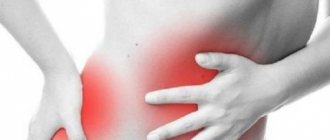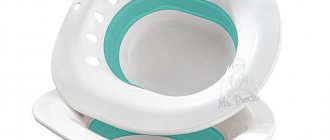- How to understand that it is time to introduce complementary foods
- Complementary feeding: how and with what products to start
- Pedagogical complementary feeding
- How to introduce complementary foods quickly and easily
Mother's milk is the best natural food for a baby.
However, the physiological development of a child requires the gradual introduction of products from the “adult” diet. And, although each baby develops in its own way, the World Health Organization has determined that the most rational is to introduce complementary foods no earlier than 6 months. It is at this age that infants develop enzymatic systems and have the first desire to try food from their parents’ table1.
How to help your child with constipation
Constipation cannot be ignored, hoping that the baby’s digestion will improve on its own. This condition always causes discomfort to the child. Please note that constipation is not necessarily associated with infrequent bowel movements. A child may poop every day, but at the same time strain, experience pain, and his stool will be formed and hard - and these are already signs of constipation. But if a baby sucks the breast with appetite, sleeps soundly, actively plays and soils his diapers, for example, after a day or two, this is most likely not constipation, but a peculiarity of his digestion.
If you are not sure whether your child’s stool is normal, be sure to consult your pediatrician. There is no need to do an enema, much less use “grandmother’s” recipes involving soap and a thermometer for prevention – “just in case.” (By the way, there are no cases at all for a thermometer and soap; these methods are simply unacceptable!) To help a child with constipation, you need to understand which condition is no longer the norm and determine the reason why the digestion failed. By eliminating it, you will save the child from the consequence - constipation. For a breastfed baby, the norm is yellow, homogeneous, mushy stool from 1-2 to 5-7 times a day. There should be no admixture of mucus and blood in it, only inclusions of white cheesy lumps are allowed. The smell should not be offensive, but simply sour. In bottle-fed children, the stool is denser and darker; as a rule, it happens less often: 1-3 times a day.
The stool of a baby of the first year may change, that is, become more liquid or denser, during transition periods when the child adapts to new conditions, in particular, to a new diet:
For example, constipation may be:
- In the first weeks of life;
- When switching to artificial feeding;
- When changing formula milk;
- During the introduction of complementary foods.
A variety of circumstances can cause constipation - from a simple mistake in diluting the mixture to congenital diseases of the digestive system. Among the most common reasons are:
- Lack of fluid, for example, preparing a more concentrated mixture than recommended by the instructions, or introducing thick complementary foods (for example, when preparing porridge, you took less water to dilute it)
- Physical or psychological discomfort associated with defecation, including irritation of the skin around the anus due to diaper dermatitis.
- Disruption of the intestinal microflora due to an infection or the use of antibacterial drugs can lead to slower peristalsis, that is, a slower movement of food through the intestines.
- Frequent uncontrolled use of enemas and certain medications, such as enzymes or laxatives. All this disrupts the natural course of digestion: it slows down peristalsis, teaching the child to defecate only after additional medicinal or mechanical influence.
- Diseases not directly related to the digestive system: rickets, hypothyroidism, iron deficiency anemia, etc.
Thus, to prevent constipation, a nursing mother needs to drink enough liquid herself: at least 2 liters per day. In the first month of a baby’s life, you need to feed on demand, and when a more or less stable regimen is established and before complementary feeding is introduced, breastfeeding should be given at intervals of no more than 3 hours during the day and 4-5 at night. For a bottle-fed baby, you need to dilute the formula according to the instructions, without violating the proportions of dry product and water.
After introducing complementary foods, regardless of the type of feeding, you need to offer additional water - a total of approximately one feeding per day, that is, 150-200 ml. If a child is prone to constipation, then the first complementary food should be vegetables, not cereal. Carefully monitor the baby's cleanliness: wash rather than use wet wipes when changing a dirty diaper, and if necessary, use diaper cream or baby powder. Do not force him to sit on the potty.
If a baby poops less than once every 36 hours, and a bottle-fed baby does not poop every day, if during the process the child strains or cries with effort, if the feces are formed and hard, contact your pediatrician.
The doctor will determine whether you are constipated or not and will advise you on how to regulate your drinking regime and nutrition in your situation, and if necessary, will prescribe procedures and medications.
It is important!
Do not self-medicate. Constipation is not a harmless disorder; it can lead to serious health problems for the child.
Mistake 3: Too fast
The decision has been made, the specialist has given the go-ahead: complementary feeding will happen! And the main thing here is not to rush. Very often, mothers and grandmothers strive to introduce their baby to all the variety of tastes as quickly as possible. There is no need to rush: he still has so much time ahead!
When introducing complementary foods, it is important to take into account that each new product is introduced over 5-7 days - starting with 1/2 teaspoon and gradually increasing the portion to the norm for age (it is usually indicated on the packaging of baby food, as well as in printed materials, which, As a rule, a pediatrician provides care for a young mother).
Never try to introduce two or more products to your baby at the same time: you will not be able to understand what the baby reacted to with digestive upset or skin rashes if this happens.
Also, do not rush and give your baby complementary foods “inappropriate for his age.” Even if a 7-month-old toddler is an excellent chewer, this does not mean that he is ready to move from homogenized puree to puree with chunks.
Tummy massage for newborns for constipation
Abdominal massage is effective for preventing and treating constipation. For prevention, it is enough to carry it out at least once a day and place the baby on his tummy more often. If constipation has already occurred, then massage sessions should be performed 2-3 times a day.
You can't massage a full belly. After eating, 2 hours should pass, and before the next meal there should be an hour or at least 30 minutes left. Before performing a massage, calm your baby down and play with him so that the baby is in a good mood. If the child cries and screams, and therefore strains the tummy, massage will not help. In order for massage movements to stimulate bowel movements, they must coincide with intestinal movements during food digestion, the so-called peristaltic waves.
How to do a tummy massage:
- Place your baby on his back on a flat surface, such as a changing table. Make sure your hands are warm.
- Do 5-6 circular strokes of the tummy in a clockwise direction.
- Proceed to counter stroking. To do this, place your right palm on top of the left side of the baby's abdomen, and the back of your left hand on the bottom of the right side. Then simultaneously stroke the baby’s belly in different directions: move your right palm down, and lift the back of your left palm up. Repeat 5-6 times.
- To work the oblique muscles, you need to stroke the sides of the abdomen. Place both palms under the child's lower back, and then, with a grasping stroking motion, move your hands up and forward towards each other, connecting them above the navel. Do 5-6 reps.
- We complete the massage again by circularly stroking the abdomen clockwise with the same number of repetitions - 5-6 times.
Does a mother's constipation affect her breastfeeding baby?
Errors in the nutrition of a nursing woman can affect the baby’s digestion. To relieve a baby from constipation, his mother will have to reconsider her menu. What dietary disorders can cause constipation?
- lack of water: if the mother drinks little, then where does the body get liquid to produce milk?
- excess foods with a fixing effect: rice, pasta, pastries, white bread, strong tea and coffee;
- lots of milk and dairy products. Constipation may result from intolerance or allergy to cow's milk protein, the most common type of allergy in the first year of life.
- There is little fiber in a woman's diet.
Constipation due to rotavirus infection
Mothers are more likely to associate diarrhea with rotavirus infection than constipation. But rotavirus causes inflammation in the intestines and disrupts its functions during illness, so constipation with rotavirus infection is quite possible:
- a sick child eats little, and when vomiting, he loses both fluid and the small amount of food that he was able to eat;
- an increase in temperature causes a large loss of moisture, liquid can be absorbed into the body, including from feces, thickening them;
- The work of digestive enzymes during illness is disrupted, and the number of “harmful” (pathogenic and opportunistic) bacteria increases, because of this, intestinal motility may slow down.
Constipation in infants when introducing complementary foods
The introduction of complementary foods, that is, the transition to a qualitatively new type of food, often causes constipation, even if previously everything was in order with the baby’s digestion. Complementary feeding products are recommended to be introduced into children's diets in addition to breast milk or formula from 4 to 6 months. Errors in introducing complementary foods can cause constipation in a baby:
- If complementary foods are introduced to a baby before 4 months, his digestion will not yet cope with other products other than breast milk or its substitutes.
- If complementary foods are introduced on time, but the consistency of the food is too thick, this can also cause constipation. Dense food will have difficulty moving through the still immature intestines. Of course, it’s difficult to make pureed zucchini or broccoli too thick, but with porridge it’s quite possible to miss the mark. Make sure that at the beginning of introducing complementary foods, the porridge is no thicker in consistency than liquid sour cream, and only then gradually transfer the baby to thicker food.
- Constipation can be caused by eating rice porridge as a first food if the child is prone to constipation. For a baby with a dense build, especially if he has stool retention, it is worth choosing vegetables to start complementary feeding. The best porridges for first feeding are buckwheat or corn. Do not forget that porridge at the beginning of complementary feeding should be dairy-free and consist of one type of cereal.
- With the introduction of complementary foods, the baby begins to need additional fluid. Offer him baby water in a bottle, cup or sippy cup throughout the day. Let him drink at least a sip. During the day, the volume of additional liquid should be approximately equal to what the baby eats in one feeding, this is about 150 - 200 ml. If water does not enter the baby’s body additionally, it will be absorbed, including from stool, which will become denser and dryer.
How to understand that it is time to introduce complementary foods
In order for the introduction of complementary foods to go smoothly, you need to focus primarily on the readiness of the child himself. The following signs will help you understand that your baby is “ripe” for adult food:
- weight after birth has at least doubled;
- the child can sit independently and can turn away from food if he doesn’t like it;
- the baby does not push out absolutely any food with his tongue and is ready to try new things;
- appetite has increased: the child attaches to the breast more often, but apparently does not eat enough;
- there is an interest in the contents of your plate.
Constipation during teething
Any number of undesirable effects - from a runny nose to an increase in temperature - are not associated with teething. Constipation, like diarrhea, is also among these symptoms. Is it really? Yes and no. The eruption of a tooth from the gum itself, of course, does not cause constipation. However, itching and pain in the place where the tooth is cut bother the baby, his appetite decreases and the temperature may even rise, which leads to increased moisture consumption. The baby eats and drinks less well, which means he poops less often. His stool may become drier and denser due to lack of fluid.
Constipation from vitamin D3
Sometimes mothers notice constipation in their babies when they start giving them vitamin D3 for prevention. This is more a coincidence than a consequence of taking the vitamin, since taking it in the prophylactic dose prescribed by the pediatrician does not cause such an effect. But an overdose of vitamin D3 can cause constipation. The fact is that vitamin D3 promotes the absorption of calcium in the intestines. In turn, excess calcium in the intestinal contents leads to the formation of difficult-to-digest compounds that thicken the stool. Do not violate the recommended dosage. With vitamins, as with other medications, more is not better.
Home cooking or industrial products?
Industrially produced porridges and purees provide a 100% guarantee that the products have passed all stages of testing and are safe for children. You can be sure that they do not contain heavy metal salts or pesticides, not to mention nitrates or GMOs. Therefore, porridges are great for first feeding. But purees that are prepared at home may contain harmful impurities, even if the original vegetables and fruits were grown independently.
Trust only verified ones. From the “First Spoon” range of products you can choose delicious and healthy dishes - in accordance with the baby’s age and his preferences.
Psychosomatics for constipation
If the child is only a month old, he will not experience constipation of psychosomatic origin. The central and autonomic nervous systems must mature to fully regulate intestinal function. Psychosomatics as the cause of constipation can be assumed in a child aged a year and a half or older, that is, at the time when he begins to be potty trained. Constipation for psychosomatic reasons can occur if:
- the baby has already experienced pain during bowel movements and is afraid of its repetition, so he holds back stool;
- parents force the child to sit on the potty, but this is unpleasant and scary for him;
- parents scold or punish the child for dirty and wet pants;
- there is an unfavorable emotional situation in the family, poor relationships between parents, a negative attitude towards the child;
- the child went to kindergarten or changed children's group. Constipation can be caused both by stress and by the fact that the baby is embarrassed to go to the potty in the presence of other children and other adults (teachers, nannies).
Almost all children experience constipation. For some these are isolated cases, for others they are regular. Parents should know what can cause constipation and how to deal with it.
So
- To help a child with constipation, first of all, sufficient fluid intake will help: in the form of an additional portion of water, both before and during the period of introducing complementary foods. You cannot use medications, enemas, or folk remedies without a doctor’s prescription.
- To prevent and treat constipation, it is worth mastering tummy massage techniques: circular, counter strokes and stroking the lateral sections of the abdomen.
- Constipation in a mother can cause the same digestive problems in a breastfed baby.
- Rotavirus infection can also cause constipation in a child.
- The period of increased risk of constipation is the introduction of complementary foods.
- During teething, constipation can be caused by poor appetite and loss of moisture due to increased body temperature.
- Prophylactic doses of vitamin D3 do not cause constipation, unlike an overdose.
- Psychosomatics as a cause of constipation begins to play a role when the child reaches the age of potty training, that is, from a year and a half and older.
(0 ratings; article rating 0)
Share Share Share
Drug therapy for stool retention
You should not give your child 6 months of age laxatives without consulting a doctor. Only a pediatrician or pediatric gastroenterologist will assess the need to use medications to treat constipation, take into account contraindications and calculate the dosage. Most often, drugs containing lactulose (Duphalac) are prescribed for children of this age. This substance gently stimulates intestinal motility without being absorbed through the intestinal walls.










